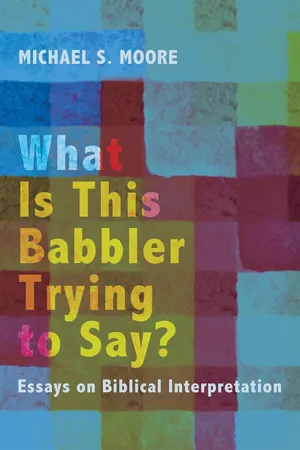
eBook - ePub
What Is This Babbler Trying to Say?
Essays on Biblical Interpretation
Moore
This is a test
Buch teilen
- 368 Seiten
- English
- ePUB (handyfreundlich)
- Über iOS und Android verfügbar
eBook - ePub
What Is This Babbler Trying to Say?
Essays on Biblical Interpretation
Moore
Angaben zum Buch
Buchvorschau
Inhaltsverzeichnis
Quellenangaben
Über dieses Buch
This book is a collection of revised-and-updated essays about the Hebrew Bible written by a North American scholar over a period of several decades. Subdivided into three parts--Torah, Prophecy/Apocalyptic, and Wisdom--these seventeen essays attempt to model for younger scholars and students what the discipline of biblical interpretation can look like, attending carefully to literary, historical, canonical, and comparative intertextual methods of investigation.
Häufig gestellte Fragen
Wie kann ich mein Abo kündigen?
Gehe einfach zum Kontobereich in den Einstellungen und klicke auf „Abo kündigen“ – ganz einfach. Nachdem du gekündigt hast, bleibt deine Mitgliedschaft für den verbleibenden Abozeitraum, den du bereits bezahlt hast, aktiv. Mehr Informationen hier.
(Wie) Kann ich Bücher herunterladen?
Derzeit stehen all unsere auf Mobilgeräte reagierenden ePub-Bücher zum Download über die App zur Verfügung. Die meisten unserer PDFs stehen ebenfalls zum Download bereit; wir arbeiten daran, auch die übrigen PDFs zum Download anzubieten, bei denen dies aktuell noch nicht möglich ist. Weitere Informationen hier.
Welcher Unterschied besteht bei den Preisen zwischen den Aboplänen?
Mit beiden Aboplänen erhältst du vollen Zugang zur Bibliothek und allen Funktionen von Perlego. Die einzigen Unterschiede bestehen im Preis und dem Abozeitraum: Mit dem Jahresabo sparst du auf 12 Monate gerechnet im Vergleich zum Monatsabo rund 30 %.
Was ist Perlego?
Wir sind ein Online-Abodienst für Lehrbücher, bei dem du für weniger als den Preis eines einzelnen Buches pro Monat Zugang zu einer ganzen Online-Bibliothek erhältst. Mit über 1 Million Büchern zu über 1.000 verschiedenen Themen haben wir bestimmt alles, was du brauchst! Weitere Informationen hier.
Unterstützt Perlego Text-zu-Sprache?
Achte auf das Symbol zum Vorlesen in deinem nächsten Buch, um zu sehen, ob du es dir auch anhören kannst. Bei diesem Tool wird dir Text laut vorgelesen, wobei der Text beim Vorlesen auch grafisch hervorgehoben wird. Du kannst das Vorlesen jederzeit anhalten, beschleunigen und verlangsamen. Weitere Informationen hier.
Ist What Is This Babbler Trying to Say? als Online-PDF/ePub verfügbar?
Ja, du hast Zugang zu What Is This Babbler Trying to Say? von Moore im PDF- und/oder ePub-Format sowie zu anderen beliebten Büchern aus Theology & Religion & Religion. Aus unserem Katalog stehen dir über 1 Million Bücher zur Verfügung.
Information
Thema
Theology & ReligionThema
ReligionPart 1: Torah
1
ANOTHER LOOK AT BALAAM*
Balaam ben Beor is a multidimensional figure, whether we examine his activity in the Hebrew Bible, in Second Temple Judaism, or on the plaster inscription from Tell Deir `Allā.1 Within the Balaam cycle in Tanak (Num 22–24) the text depicts him as Yahweh’s “obedient servant.”2 Yet within this cycle he also behaves as a bungling buffoon in a satirical “burlesque,”3 a blind “seer” unable to “see” Yahweh’s angel standing directly in his path. Micah of Moresheth preserves a memory of him acting as Moab’s antagonist (Mic 6:3–5), but most Tanak sources depict him as Israel’s quintessential antagonist.4
This polarized response to Balaam hardens in several Second Temple texts. Ps.-Philo, for example, continues to portray him as God’s faithful “servant” (Lat servum tuum)5 while an anonymous rabbinic commentator calls him “a prophet greater than Moses.”6 Contradicting these portrayals, however, the Fragment Targums,7 Talmud,8 and Greek New Testament9 all portray him as “Balaam the Wicked.”10 Recognizing the danger posed by such lopsided polarization, Josephus cautiously suggests that readers go back to Tanak and examine it carefully before making up their minds about Balaam.11
The Deir `Allā texts give us more information. Here Balaam appears as a “seer of the gods” (ḥzn ’lhn) on the first line of Combination 1,12 an envoy allegedly chosen by a divine council to convey a doomsday oracle to a local populace. Combination 2, however, though more fragmentary, depicts him in categories more congruent with the occultic activity alluded to in Num 31:16.13 Whatever the interpretive possibilities,14 the DA discovery removes all doubt about the existence of a non-Hebrew Balaam tradition in Iron Age Transjordan among a people evidently non-Yahwistic and probably non-Israelite.
Yet in spite of this new evidence several studies of this ancient Near Eastern specialist continue to constrict his multidimensionality within bipolar parameters first proposed by nineteenth-century literary critics to explain, prior to the great archaeological discoveries of the twentieth century, the character and development of Torah. Within this framework Balaam is either a “blesser” or a “curser,” but these are the only options.15 The vestigial “2-source” hypothesis underlying this polarized framework has been and continues to be contested. Some angrily rail at it;16 others try to work within its bipolar parameters (often without presuming the existence of independent literary “documents”);17 and still others ignore it.18 Few attempt to engage seriously the sociohistorical context out of which the Balaam traditions originate.19
The question raised here is therefore simple. Is Balaam only a “curser”/”blesser,” or is the nineteenth-century bipolar approach to the Balaam traditions inadequate and outdated? Without denying that Tanak editors largely succeed in corralling the Balaam traditions within enclosures structured by the “blessing-curse” polarity,20 perpetuation of this nineteenth-century approach practically guarantees that the multidimensional roles enacted by this specialist will remain hidden from view. Better to switch methodological gears and re-examine the Balaam traditions from a perspective informed by selected anthropological studies of religion,21 especially the adaptable variables generated by co...